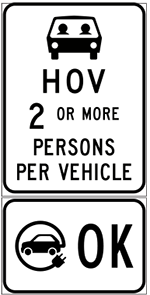Electric Vehicles in HOV Lanes on B.C. Highways
Eligible electric vehicles (EVs) may access certain high occupancy vehicle (HOV) lanes in B.C.
Eligible vehicle criteria
The definition of an electric vehicle is a vehicle propelled by an electric motor and powered by a battery that can be charged from an external electricity source.
- Fuel types:
- Battery electric vehicle (BEV)
- Plug-in hybrid electric vehicle (PHEV)
- All sizes of eligible EVs are allowed, including light-duty, medium-duty, and heavy-duty EVs
- If you live outside B.C., you are permitted to drive your single-occupancy eligible EV in HOV lanes
Overview
Access to HOV lanes by eligible EVs is determined solely by signage.
EVs with single driver are allowed in these HOV lanes if there is a sign indicating they are allowed.

Benefits
EVs are allowed in select HOV lanes.
Map
List
Lower Mainland
- Highway 1: Westbound from east of 202 Street to Gilmore Way overpass
- Highway 1: Eastbound from Gilmore Way overpass to 208 Street overpass
- Highway 7: Westbound HOV lane starts past (West of) Golden Ears Way and ends just ahead (East) of Old Dewdney Trunk Road
- Highway 7: Eastbound HOV lane starts past (East of) Old Dewdney Trunk Road and ends just ahead (West) of Golden Ears Way
- Highway 17A: Northbound only Ladner Trunk Road to Highway 99
- Highway 99: Northbound south of Highway 17 to north of Highway 17A
- Highway 99: Southbound south of Westminster Highway to north of Steveston Highway
Kelowna
- Highway 97: Northbound Pandosy Street to Sexsmith Rd/Old Vernon Road
- Highway 97: Southbound Sexsmith Rd/Old Vernon Road to Pandosy Street
Apply
Drivers of eligible plug-in hybrid or battery-electric vehicles no longer need a visible ‘OK’ decal to access certain high occupancy vehicle (HOV) lanes in British Columbia.
These changes reflect the strong uptake of electric vehicles in the province and ensure that access to HOV lanes for all permitted drivers continues to be clear and efficient.
The Ministry of Transportation and Transit will continue to monitor the capacity of HOV lanes across the province to ensure they remain effective for all permitted users.
